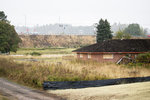

The Port of Centralia announced Wednesday a new ramp off the Mellen Street Interstate 5 overpass has been approved by the Federal Highway Administration, paving the way for the development of Centralia Station.
It was the final permit needed before construction planning for the proposed 43-acre multi-use development could begin. The development will likely feature Fred Meyer as the anchor tenant.
“It was always going to be approved. It was just an issue of going through the process,” Port Executive Director Kyle Heaton said after the regular Wednesday meeting of port commissioners.
It will extend from the existing overpass south of Mellen Street into the area where the station will be constructed near what is now Long Road.
The Washington Department of Transportation will begin designing the interchange next year, Heaton said. Construction is likely to begin in 2019.
The project is funded through a 2015 state transportation package in which $4.53 million was earmarked for the project, The Chronicle reported in April.
Heaton said the final cost estimates will not be available until the project is designed, but there are plenty of funds available for the project, he added.
“It is exciting to see this come to fruition,” Port Commissioner Julie Shaffley said.
Centralia Station is a project spearheaded by the port, which announced earlier this year it was partnering with Powell Development. It is expected to include a Fred Meyer and dozens of other businesses, including retail stores, offices and restaurants. A hotel and medical facilities have also been discussed as potential tenants.
According to the report from ECONorthwest last year, the $53 million construction phase of the project would require 410 fulltime employees and support 575 jobs throughout the local economy, adding $26.4 million to local labor income. The construction period was estimated to contribute $4.6 million in state and local taxes. The construction is expected to trigger additional local spending, according to the forecast, which would result in a one-time impact of $76.3 million.
Once the complex opened, the report estimated it would employ 535 people in Centralia at the businesses, which ECONorthwest predicted at the time would include 10 stores, four restaurants, a bank and a gas station, totaling $118 million in annual sales, according to the report. Centralia Station would earn an estimated $118 million in annual sales and pay almost $7.1 million in state and local taxes, according to the report. In the first 10 years of operation, Centralia Station would pay the present year equivalent of nearly $5 million in property taxes, according to the report.
“We are excited about the jobs it will bring,” Centralia-Chehalis Chamber of Commerce Executive Director Alicia Bull said on Wednesday after the port meeting where the announcement was made. “It is the best news I’ve heard all day.”
At the Centralia-Chehalis Chamber of Commerce’s April forum, Peter Powell, of Powell Development, said the exit interchange is essential for the project to allow larger volumes of traffic to flow into the retail area.
“Without that access, we go away,” Powell said at the forum.
The funds were allocated with the help of Sen. John Braun, R-Centralia, and Rep. Richard Debolt, R-Chehalis, Heaton said.
“Improving access to this new development will support significant economic development and create job opportunities benefitting area residents,” Braun told The Chronicle in April. “Centralia Station is a great example of private development and government working together to help meet the current and future needs of our community.”
On the city’s side of things, more information will be needed before any infrastructure improvements can be planned, Centralia City Manager Rob Hill said. The full scope of the project will need to be known in order to address its utility needs, he said.
The sewer system in the area will need to be upgraded in order to accommodate the larger load, The Chronicle reported in August.
Hill said the port will need to communicate the infrastructure needs to the city during the design process. At this point, the city is in a holding pattern until its role has been made clear, he said.